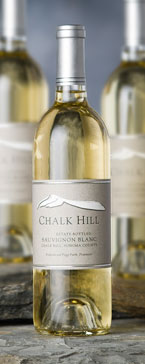Chalk Hill Winery, Chalk Hill (Sonoma County, California) Sauvignon Blanc 2005 ($30)
This review begins in a confessional tone. I once followed the wines of Chalk Hill closely, but then I forgot all about them. Back when David Ramey was winemaker, this was one of my favorite California wineries. I was intrigued by Ramey’s then avant garde techniques such as barrel fermentation with ambient yeast, and I adored the wines, especially the whites (especially the Sauvignon Blanc). Then I moved on. Too many wines and wine regions, too little time, I suppose. Mea culpa.
Fifteen years later, I am delighted to discover that I still love Chalk Hill’s wines, and that the Sauvignon Blanc still excites me. It is a very different wine than it was in the early 90s, and I like it even more. Then it could have been the poster child of the Chardonnay-wannabe school of Sauvignon Blanc, a fabulously full-bodied, round, oak-influenced wine that challenged you to find the Sauvignon Blanc within its huge, rich weight. Today, just one whiff tells you that the wine is Sauvignon Blanc through and through.
 Chalk Hill is an estate winery in Sonoma County, in the small Chalk Hill AVA, which lies east of Russian River Valley and southwest of Alexander Valley. The winery’s 350 acres of vineyards – on a beautiful 1200-acre estate – are enormously varied in soil and altitude, which enables the production of very rich, very ripe red wines as well as more delicate white wines. Winemaker Steve Leveque spent 11 years at Robert Mondavi before joining Chalk Hill. The VP of vineyard operations, Mark Lingenfelder, who has been at the estate since 1980, has made Chalk Hill a leader in clonal research, not only in Chardonnay but also in Sauvignon Blanc.
Chalk Hill is an estate winery in Sonoma County, in the small Chalk Hill AVA, which lies east of Russian River Valley and southwest of Alexander Valley. The winery’s 350 acres of vineyards – on a beautiful 1200-acre estate – are enormously varied in soil and altitude, which enables the production of very rich, very ripe red wines as well as more delicate white wines. Winemaker Steve Leveque spent 11 years at Robert Mondavi before joining Chalk Hill. The VP of vineyard operations, Mark Lingenfelder, who has been at the estate since 1980, has made Chalk Hill a leader in clonal research, not only in Chardonnay but also in Sauvignon Blanc.
Chalk Hill Sauvignon Blanc 2005 contains 6 percent Semillon and 6 percent Sauvigon Gris, selected from 11 clones of these varieties. The wine is still ‘barrel fermented’ but 20 percent of the barrels are stainless steel, and only 25 percent of the French oak barrels are new. Leveque prefers the stainless steel barrels to larger tanks because the smaller size enables the wine to gain creaminess from lees contact, the way that it would in similar-sized oak barrels. He whole cluster-presses the grapes and avoids exposing the juice to oxygen, to preserve the grapes’ aromatics. He also avoids malolactic on this wine.
The effect of oak on the wine is now almost subliminal. The nose is fresh, focused and penetrating, just as you’d expect from Sauvignon Blanc, with vivid fruity notes – passion fruit and lime zest, to name two. (I suspect that I detect a slight smoky note only because I know that the wine is oaked.) In the mouth, the wine is fairly full-bodied, soft and silky smooth, with a slight initial impression of sweetness (possibly from the wine’s 14.1 percent alcohol, or its ripe fruit, or the oak) that turns dry when it confronts the wine’s crisp acidity and very slight phenolic character (itself probably from the lees aging). The flavors give a leaner expression than the full body and silky texture do. They are vibrant, fresh and intense fruitiness, again suggesting ripe citrus and passion fruit, and they carry across the length of the palate into an explosive fruity finish.
I hope that all this sounds delicious, because the wine certainly is. From a technical perspective, what’s fascinating to me is the combination of the vibrancy of the grape itself and the richness and softness rendered by barrel fermentation and aging on the lees. And remarkably, the wine has not a trace of vegetal or ‘catty’ character that Sauvignon Blanc can sometimes have, nor a trace of oaky flavor. Pre-fermentation skin contact for 30 percent of the grapes and the absence of ML explain the elevated varietal aromas; that the barrels are not all new – and not all wood, for that matter! – explains the lack of oak flavor.
This wine enlivens dishes with simple flavors, such as fish filets or simple chicken or veal cutlets. But it can stand up to a spicy peanut sauce on that chicken, or a rich butter, lemon and caper sauce on the veal. It’s just made for goat cheese, and yet can handle a tomatoey squid antipasto.
92 points
